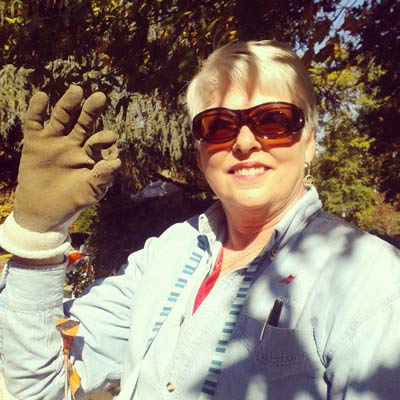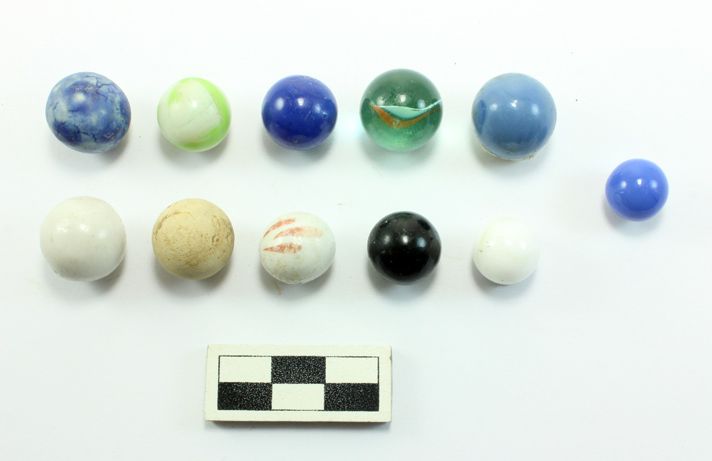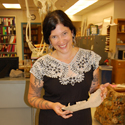Digging Jacksonville – March 2016
The days of free-roaming youngsters and unsupervised play are gone, it seems, here in Jacksonville, but we can still see children in Doc Griffin Park or playing in yards and cul de sacs. The sleepy town of the 1950s saw school-aged children and teens riding their bicycles, walking to school, and playing in the streets and on the worn pathways. They made their own trails in the surrounding woods, built unapproved tree houses, and waged war on enemies in the culverts and ditches. Evidence of children through the decades is found in yards and byways.
During the recent archeological excavations by the Southern Oregon University Laboratory of Anthropology (SOULA), I have been fortunate to join them as a volunteer, digging unwittingly into my own past. Doll parts, game pieces, marbles, toys and toy fragments, shards of porcelain tea sets, and feeding nipples have been unearthed on Main Street, First Street, and the Britt grounds. Among them, artifacts have been items I clearly identified as having belonged to me! These came from the site of The Booker House where I spent my early childhood with my brother. Older toys from this site were likely possessions of the Biede girls who lived in the same house in the late nineteenth century.
A favorite found artifact of mine is the bright blue glass piece originally labeled “glass marble” that is likely one of the blue pieces from our Chinese Checkers board game. The German toy market created this popular game in 1892. Originally called Stern-Halma, it is still played today. Surely, Stern-Halma would have found its way to Jacksonville’s German community.
The flat, worn sidewalks on the side streets made good surfaces for drawing a circle with a stick to give several players room to kneel to shoot marbles carried in drawstring bags. The game of Marbles was apparently popular for generations. The earliest marbles are larger and hand-made of clay. The small ones are “pee-wees” and the larger ones “shooters.” The more modern glass marbles are called cat’s-eyes and sunbursts. We found examples of each kind.
Finding and identifying artifacts associated with children tells us that young people enjoyed games similar to those today and spent time out of doors. Holding some of the objects screened from the soil brought memories of the wonderful childhood I had here in Jacksonville and caused me to ponder the children who played in the spot before I did and to hope that children would continue to play happily in our town and leave evidence behind. Archeological examination of sites in Jacksonville gives us information about those who preceded us, poses questions about their daily lives, and reminds us of our place in the history as we move into the future, preserving the history of Jacksonville for children to come.
 Gayle Lewis is a retired Women’s Health Nurse Practitioner whose family has lived in Jacksonville since 1880. She is a Southern Oregon Historical Society volunteer who works with the Southern Oregon University Laboratory of Anthropology. You can reach SOULA by contacting Chelsea Rose at rosec@sou.edu and follow SOULA on facebook/Southern Oregon University Laboratory of Anthropology.
Gayle Lewis is a retired Women’s Health Nurse Practitioner whose family has lived in Jacksonville since 1880. She is a Southern Oregon Historical Society volunteer who works with the Southern Oregon University Laboratory of Anthropology. You can reach SOULA by contacting Chelsea Rose at rosec@sou.edu and follow SOULA on facebook/Southern Oregon University Laboratory of Anthropology.

 Chelsea Rose is an historical archaeologist who specializes in the settlement and development of the American West. Chelsea and the Southern Oregon University Laboratory of Anthropology (SOULA) conduct archaeology across Oregon and have done several projects in Jacksonville. You can reach Chelsea at rosec@sou.edu and follow SOULA on
Chelsea Rose is an historical archaeologist who specializes in the settlement and development of the American West. Chelsea and the Southern Oregon University Laboratory of Anthropology (SOULA) conduct archaeology across Oregon and have done several projects in Jacksonville. You can reach Chelsea at rosec@sou.edu and follow SOULA on